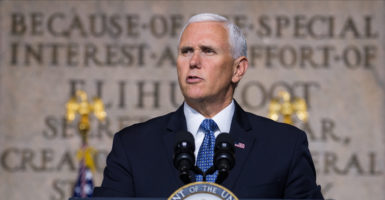One of the issues that will face the new Congress is the creation of a new military service: the U.S. Space Force.
Recently, Vice President Mike Pence chaired the fourth meeting of the National Space Council. The council is comprised of key elements of the U.S. government that are involved with space, and includes not only the chairman of the Joint Chiefs of Staff and the secretaries of state and defense, but also the secretaries of commerce, transportation, and homeland security, as well as the director of national intelligence, the director of the Office of Budget and Management, the head of NASA, and the national security and homeland security advisers.
The venue was significant—Roosevelt Hall at the National War College. Established in 1946, the National War College seeks to train the next generation of senior officers and national security civilians in the ways of grand strategy, including how to balance resources available against requirements. Thus, the announcement that the National Space Council would unanimously endorse the creation of the new Space Force was intended to send a strategic signal.
To this end, the vice president in his remarks specifically noted the six recommendations that would be made to President Donald Trump:
- Creation of a new unified combatant command: the United States Space Command. This would elevate command of space operations to the level of U.S. Special Operations Command.
- Creation of a new organization, the Space Development Agency. This new agency will accelerate the development of new space capabilities.
- Reorganizing the resulting bureaucracy, and laying out a path for rapid fielding of that new space technology.
- Altering the current rules of engagement for space to allow more effective responses to potential space threats.
- Reviewing and revising the legal authorities associated with the employment of space forces. While this appears to simply be more legalese, in reality, establishing which organizations have what legal authorities is a massive part of how the U.S. military operates. Because of the need for U.S. forces to operate within the law—international laws and treaties as well as domestic laws and regulations—laying out the authorities is vital to ensure that military responses are smooth and unencumbered by legal challenges.
- All this is to lay the foundations for the creation of a new service, the United States Space Force, which the vice president made clear would be proposed in the next National Defense Authorization Act.
While late-night comedians found the whole idea of the Space Force hilarious, the reality is that the United States faces growing threats from space. These include not only anti-satellite missiles that can shatter satellites into thousands of pieces of debris, but lasers capable of “dazzling” and blinding satellite systems, as well as cyber and jammer threats. The range of potential space adversaries includes not only Russia and China, but, as the vice president noted, also Iran and North Korea.
Nor is the U.S. the first nation to create a service dedicated to space operations. In 2015, the Russians established the Russian Aerospace Forces, merging the Russian air force and the Russian Aerospace Defense Forces. This entity has control over Russia’s air force, Russian missile defense forces, and key parts of the Russian space infrastructure, such as the Plesetsk Cosmodrome (launch facility).
Meanwhile, at the end of 2015, the People’s Republic of China established the People’s Liberation Army Strategic Support Force. This new force marks a very different path than the Russian Aerospace Forces.
Under the People’s Liberation Army Strategic Support Force, the Chinese have brought together their electronic warfare, network (cyber) warfare, and space warfare forces. Thus, where the Russians see space as an extension of the air, the Chinese see space as an extension of information space. This difference explains why the Russians created a single aerospace force, while the Chinese created a single information warfare force.
Since such massive reorganizations take time, this means that both China and Russia were undertaking significant analyses and preparations long before the announcement in 2015. Thus, the United States, far from militarizing space, is in fact likely to be years behind our Russian and Chinese counterparts.


























